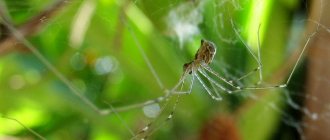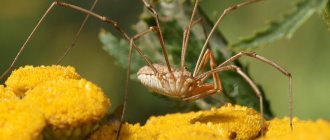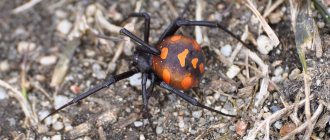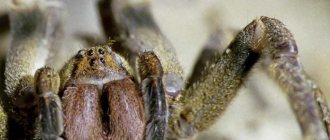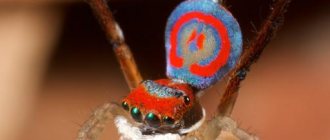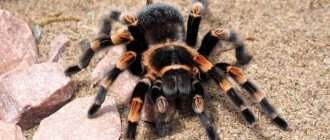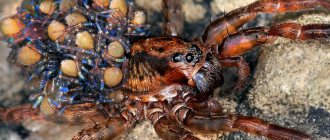Want to learn something new and scary? In the rainforests of Ecuador there is a creature that looks like a large black head of either a hare or a dog, which is attached to eight very long yellow legs. To be honest, the mere description of this arachnid makes me uneasy (hello, arachnophobia). And although it feels like this is the creation of a mad scientist who, as usual, “doesn’t know what he’s doing,” nature created the “bunny harvestman” on its own. The only question is “why,” but it applies generally to everything that surrounds us, so let’s skip it and focus on the amazing discovery of naturalist Andreas Kay. As it turned out, the strange arthropod is in fact not a spider at all, but a representative of a detachment of harvestmen who lived on our planet even before the appearance of dinosaurs.
Just look at him! And it’s not photoshop or a crazy science experiment.
Characteristic
The harvestman is a spider that is known for its long (up to 9 cm) legs. There are more than 6,000 species of these arachnid chelicerate arthropods. Scientists have divided them into four suborders. About 60 species are found in our region.
Externally, the harvestman is similar to a spider, but has significant differences from the representatives of this order. These arthropods are generally considered to be the result of parallel evolution. Harvesters are more like insects: internal fertilization, developed tracheal respiration, eggs are laid deep in the substrate, and they have the ability to chew coarse particles of food and digest them. They do not weave webs due to the absence of glands that produce such a secretion. They hunt small insects or feed on plant foods.
Most representatives of the class have a one-year life cycle. The eggs or juveniles of the autumn generation overwinter. Harvesters hatched in the spring go through several molts and become sexually mature by summer. In tropical species, two generations are possible. The maximum life expectancy is two years.
Lifestyle
Harvesters are mainly predatory, hunting small insects and arachnids. Some species specialize in terrestrial mollusks. There are also haymakers who feed on animal and decaying plant food and animal droppings. Unlike spiders, they can feed not only on liquid food, but also ingest solid particles.
After mating, the female lays, using the ovipositor, from several tens to several hundred fertilized eggs into the soil, wet moss, leaf litter, etc. The eggs are covered with a sticky protective secretion. Newborn harvesters must go through 5–7 moults until they become sexually mature. In some species, elements of metamorphosis occur in development. The youth of such harvesters are very different from adults. Most temperate grasshoppers have a one-year life cycle: they emerge in early summer, breed in July-August, and overwinter their eggs and young. Some species manage to produce two generations per season, and the young of the autumn generation overwinter. The maximum lifespan of harvestmen reaches 2 years.
Name
People also call these arachnids “braids”. They got it because of the structural features of the limbs. The fact is that the severed leg of the haymaker continues to move for some time. They vaguely resemble the mowing process.
Losing a limb is not fatal. It is believed that the harvester (spider) cuts it off himself in order to escape from danger on his remaining legs. The wound quickly becomes clogged and the liquid internal environment of the arachnid (hemolymph) does not flow out.
There is another aspect to this behavior. The attacker, left with a twitching paw, will be busy for some time observing the “mowing” process, which will give its owner the opportunity to try to escape to a safe distance with the remaining limbs and have time to use additional means of defense.
Myths and confusion
Some people believe that the hay spider is poisonous, meaning the hay spider. You can hear another version of the judgment that these creatures have very strong poison, but cannot bite through human skin. Let's try to figure out if this is really the case.
You should immediately pay attention to the definition. The harvestman is not a spider. The pigtail belongs only to the order of arachnids. Another thing is the haymaker spider. It is also popularly called centipede. This representative really belongs to the order of spiders. It bears a vague resemblance to a haymaker, mainly due to the length of its legs, but has a different lifestyle: it weaves nets, catches insects in them, and has glands with poison, which it uses to kill its victims.
Settlement area
It's time to find out where these amazing creatures live. Haymakers settled almost everywhere, occupying various natural landscapes.
The main species have chosen forests and meadows. They are found in mountain ranges, settling in rock crevices and caves. Some species have easily adapted to living conditions in cities, and therefore can be found in apartments, houses, and office premises.
Habitat
Haymakers are distributed throughout the world. More of them are found in southern and temperate latitudes, but there are species that live in climatic zones with low threshold temperatures. Some representatives climb the mountains to the borders of eternal snow. They prefer to hunt at night, but some species are active during the day. Most haymakers inhabit forests, many of them are in meadows, and they are typical representatives of urban landscapes. During the daytime, you can often find haymakers frozen with their legs outstretched on the walls of houses.
At night they search for food, moving on long limbs. The second pair of legs of the haymaker also serves to feel objects along the path. Sensing danger, the haymaker quickly runs away and can jump from a height, spreading its limbs, which act as a parachute. Moreover, he always falls belly down and immediately continues running.
What does the haymaker spider eat? Representatives of this order are predators. They settle in secluded places, looking for a suitable niche. To catch prey, trapping nets are built. The threads are not sticky, but they are arranged chaotically, and small insects that get caught in them and try to get out most often become entangled and become prey for the spider.
Fighting methods
The centipede is one of the most common spiders living in apartments. Most often it can be found near a window or in a dry, dark corner, where it hangs upside down in its chaotically woven web. And if being around a haymaker spider is unpleasant for you, then it is advisable to find out how to get rid of it.
The work of removing centipedes from the apartment is divided into two stages.
The first stage is cleaning
At this stage you need to do the following:
- We seal all the cracks and close even the smallest openings through which this spider is able to get into the apartment. We install nets with small cells on ventilation grilles and windows.
- We reduce the brightness of natural light - to do this, just hang blinds on the windows. This is unattractive to insects and, therefore, spiders will not appear in the house, since the latter feed first.
- Every day we clean all corners of the apartment: we use a broom in the corners, under the ceiling, behind cabinets, cabinets, around windows and under beds.
- If you find cobwebs together with the owner, then it is advisable to remove them at the same time - a regular mop with a wet rag does an excellent job of this.
- We periodically prevent the appearance of insects in the house, and if they appear, we make sure to destroy them immediately. Otherwise, the haymaker spider will happily settle where there is a lot of food.
- We humidify the air in all rooms in the house and at the same time make sure that dampness does not form.
The second stage is scaring away
The simplest folk recipes, which have been repeatedly tested by our grandmothers, will help us with this. They can quite easily cope with hay spiders and prevent their reappearance.
So, centipedes, like many other spiders, cannot tolerate the pungent odors that some plants emit. Among them:
- Mint – It is known for its intense aroma, which, as it turns out, works great not only against insects, but also against spiders. In this case, you can use both the dry leaves of this plant and its essential oil: we place the dried parts in the corners, and add the essential oil to the water and sprinkle it in all rooms.
- Oranges, chestnuts and hazelnuts - a set of these products can also help in the fight against centipedes. We crush or cut them into pieces and leave them in places where the web or the spiders themselves were found.
- Tea Tree and Eucalyptus – These are used as essential oils in a similar way to mint. Add a few drops to the sprayer and treat all hard-to-reach places in the rooms.
If you carry out the above procedures regularly, they will certainly bring positive results.
Nutrition
The diet of harvestmen is more varied than that of spiders. They, by and large, are also predators, but, in addition to captured animal food (beetles, caterpillars, flies, ants), they can also feed on carrion, and do not disdain the remains of rotting plants, fungi, and even animal excrement and bird droppings. Some species are selective and prefer to eat snails and slugs.
Their oral apparatus is equipped in such a way that it makes it possible to chew food and then digest it inside the body. They tear off hard pieces, bring them to the mouth and chew them with processes adapted for this purpose.
Unlike the haymaker spider, the haymaker spider has venom. He uses it to kill a victim caught in his trap. Before this, the spider entangles it in a web, and then decides to eat it right away or leave it hanging in the cocoon for later.
Natural enemies
In the wild, spiders have many natural enemies. They form part of the diet of many predators. That is why haymakers tend to settle in human dwellings, where there is almost no threat to them. Natural enemies:
- rodents;
- birds;
- snakes;
- lizards;
- toads.
Although some pets also pose a danger to spiders. Cats and dogs hunt for them not to eat them, but for the sake of interest and fun. But over time, the pets stop paying attention to them, and the haymakers remain safe.
In apartments, other spiders remain their enemies. They may belong to other families or be brothers. Some mushrooms of the genus Cordyceps also become a problem for thin-legged mushrooms. They infect the spider's body and gradually grow inside it. All internal organs are affected and slowly destroyed, causing the arthropod to die. The fungi break through and eat the spider completely, not even its chitinous covering remains.
Although most species of harvestmen have non-sticky nets, some use a special glue. It is secreted by hairs located on the pedipalps. This composition allows you to instantly capture the victim. The spider only needs to touch it once to stick it to its paws.
Appearance
In addition to the mentioned long legs, the harvestman (spider) has a short (up to 1 cm) body. In some species it can reach a length of 2 cm and have an oval shape. In the harvest spider, the body is divided by a thin bridge into the thoracic and abdominal sections. The braids lack this feature. Their body is also segmented, but the cephalothorax and abdomen are connected by a rigid wide plate.
The body cover is armored. There is a pair of eyes on the head (long-legged spiders have eight). There may be outgrowths on top of the shell. The color is mostly dark grey, brown or black. Species that prefer to hunt during the day are more variegated in color.
In addition to long legs, harvestmen have a pair of pedipalps. They are used by arachnids to grab and bring food to their mouths. Another pair of chelicerae are used as jaws and serve to chew solid particles.
Peculiarities
Haymakers do not have leg extensor muscles. Lifting of the body and movement occurs according to the hydraulic principle. The legs are hollow inside. They contain a liquid medium (hemolymph), which replaces blood to a certain extent. By building up pressure, the haymaker straightens his legs.
There are a pair of holes on the sides of the cephalothorax. These are the exits of the odorous glands. Their harvesters can use them in case of danger. The contents with a pungent vinegar smell shoot out at a distance and scare away predators. Therefore, the braids have almost no special enemies.
The mating season of harvestmen usually occurs at the end of summer. The male, having met a female along the way, mates and, without stopping, is poisoned further. Occasionally, haymakers fight for girlfriends. In some species, males participate in caring for future offspring. While protecting the clutch, they are sometimes forced to drive away the females, since they can eat everything.
There are usually up to 50 eggs in a cocoon. During the season, female harvesters manage to lay several clutches with a break of up to three weeks. The substrate for this is chosen among the foliage; moss and loose soil can be used.
Reproduction
At the end of summer, the mating season begins for the haymakers. They completely lack marriage rituals. Having met a sexually mature female, the spider quickly mates and goes about its business.
The female lays up to 50 eggs. She places them in a cocoon one at a time or in small piles under fallen leaves, in moss or simply in loose soil. She carries out this procedure using the ovipositor located in the lower part of the abdomen. The period between clutches ranges from several days to 3 weeks.
The eggs remain dormant throughout the winter. With the onset of spring, small spiders emerge from them, which immediately scatter in different directions. The young quickly adapt to the environment, and with the arrival of autumn they are already capable of giving birth to a new generation of hay spiders.
Is the haymaker spider dangerous?
Long-legged arthropods can cause horror in impressionable people. However, the myths mentioned above have no basis. The harvestman cannot be poisonous because it does not have glands that produce such a secretion. The very possibility of a bite is also questionable.
Can the haymaker spider be dangerous? It makes no sense for him to bite a person, he will not bite through the skin, and he is accustomed to injecting poison only into a victim entangled in a web. There is no laboratory data on the extent of the effect of its poison on humans. There are also no medically known cases of people being bitten by representatives of long-legged spiders.
On the contrary, harvesters are believed to provide benefits by catching and eating various insects that could cause harm. Long-legged spiders, because they catch flies and mosquitoes, also cannot be considered enemies of humans.
What does it eat?
Typically, the following insects get caught in the harvester's net and are unable to escape from the trap:
- small snails;
- ants;
- small caterpillars;
- slugs;
- bugs;
- mosquitoes;
- various midges.
In the absence of fresh food, moss spiders are forced to feed on carrion (the remains of flies, mosquitoes and other small insects), excrement, fungi, and rotting remains of organic matter (both meat and plant matter).
Did you know? To avoid getting caught by an insect that is too large, harvesters deliberately loosen the net to scare it away. If this does happen, then the spider helps free the failed food by biting off the necessary threads.
When these spiders have seasonal problems with food, they are not averse to cannibalism - in difficult times, related subspecies or even representatives of their own species can be eaten. To do this, insects find a “relative’s” web, pretend to be entangled in it and attack the web owner who has run up.
The most poisonous spider
Unlike the haymaker, the black widow can seriously harm a person. The small (2 cm) size of this spider cannot be compared with the effect of the venom, which is stronger (up to 15 times) than that of a rattlesnake. In weakened elderly people and children, the bite of these arthropods can be fatal. Spiders are especially dangerous. Their color is black; on the abdomen there is a small bright spot in the shape of an hourglass. Widows weave webs. Its threads are very strong and arranged randomly. It may seem that these traps are abandoned because of the stuck debris (leaves, blades of grass), but the black mistress is usually hiding in a secluded place nearby.
The most poisonous spider lives in Brazil. It is also called banana because it likes to climb into the baskets of those who pick these fruits, and wandering because it does not weave trapping nets and does not stay in one place. The size of this spider is more impressive. It grows up to 19 cm with a leg span of up to 12 cm. When in danger, the spider stands on its hind legs and displays threatening fangs.
The six-eyed sand spider from Africa also poses a threat to humans. In our region (southern regions), karakurts pose a serious danger. The spider bite is not immediately felt, but after a few minutes a sharp pain spreads throughout the body. Outwardly, they resemble black widows (red dots on the abdomen). Which is not surprising, since these are representatives of the same genus.
